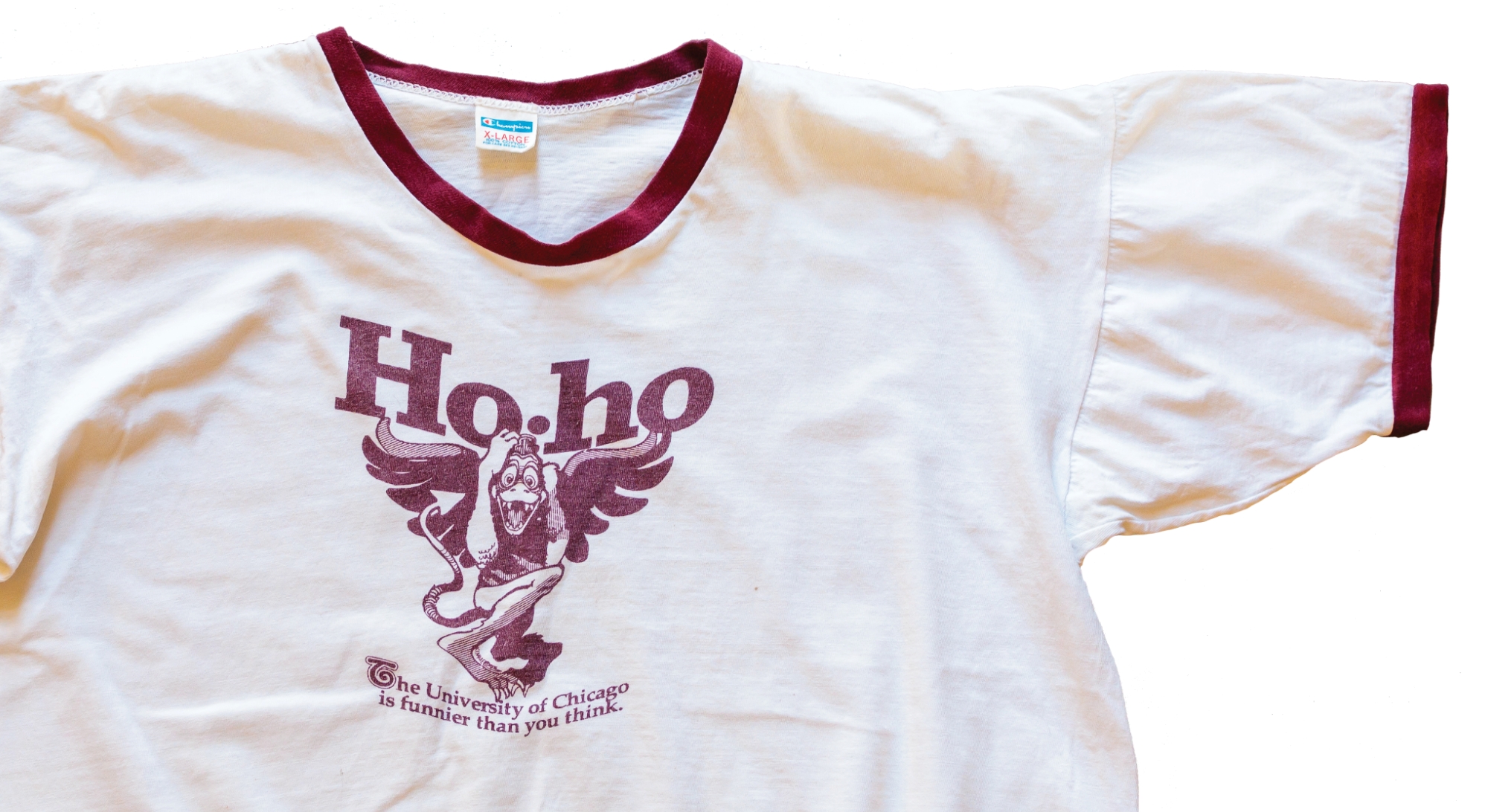
The “Ho-ho” T-shirt, possibly UChicago’s earliest novelty T-shirt, was a collaboration between Leslie Strauss Travis, AB’73, and Maroon cartoonist Richard Kimmel, SM’90. (Photography by John Zich)
An oral history of College life in the 1970s.
If today’s students were able to travel back in time to the College of the 1970s, “it would feel very foreign,” says Paula Szewczyk Ausick, AB’72. “It would be like a whole other country.”
Over the years, while working on The Core, I had heard occasional rumors—legends, maybe—about the student culture of the 1970s. There was a giant kazoo, apparently. A fancy dress ball, held in Ida Noyes, where you got in free if you were naked. Also varsity football.
This past summer, The Core’s Metcalf interns—Rory McGann, Class of 2025, and Shiloh Miller, Class of 2026—asked 20 College alumni and administrators what the ’70s were really like. “Both wacky and weighty,” is how Miller describes it. In the early ’70s especially, during a period of national political unrest, student levity was tinged with anger, frustration, grief.
“I had the honor of being there at a time where either you were camping out on the main quad in protest against the war in Vietnam, or to be first in line for registration for Karl Weintraub’s [AB’49, AM’52, PhD’57] Western Civ section,” says Leslie Strauss Travis, AB’73 (who came up with the idea for the “Ho-ho” T-shirt shown here). “I got a very different education than I would have, had I been there ten years earlier.”—Carrie Golus, AB’91, AM’93
Speakers
Jim Vice, EX’55, AM’54, various administrative and teaching positions, 1953–75
Dan B. “Skip” Landt, AM’62, assistant dean of students and student activities director, 1967–75
Bill King, AB’69
Roger Black, EX’70
Seth Masia, AB’70
David Travis, AB’71
Paula Szewczyk Ausick, AB’72
Pamm (Reichl) Collebrusco, AB’72, AM’74
Dorthea Juul, AB’72, PhD’89
Alphine Jefferson, AB’73
Leslie Strauss Travis, AB’73
Barbra Goering, AB’74, JD’77
Frank Gruber, AB’74
Alice Leiner, AB’74
Bruce Gluckman, AB’75
Donald Bingle, AB’76, JD’79
James Lawrence Fuchs, AB’76, AM’77, PhD’83
Hanna Holborn Gray, president of the University of Chicago, 1978–93
Julian Brown, AB’77, AM’78
Ron Gagnon, AB’79
Interviews have been edited and condensed.
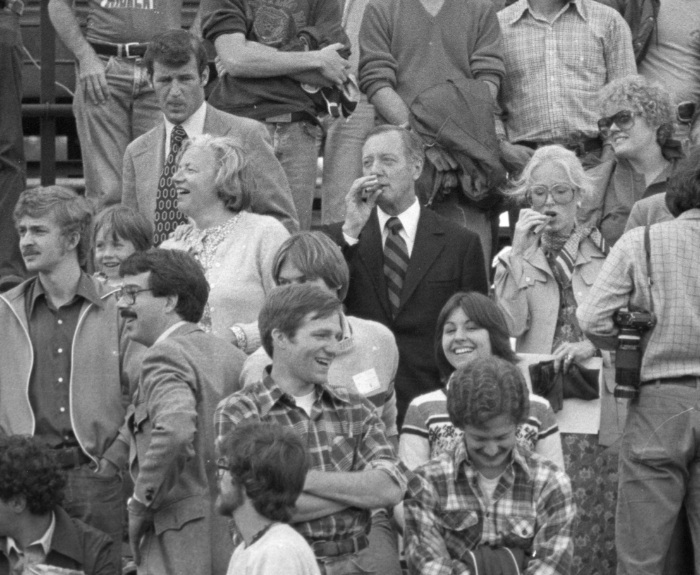
Big Ed, the world’s largest kazoo
In 1969 varsity football returned to UChicago after a 30-year absence. Reactions were mixed. For some students, the football field was an untapped well of amusement—a well that spilled forth during halftime, as the fez-topped members of the University of Chicago Marching Kazoo Band paraded Big Ed, a 15-foot-long kazoo, around on the grass.
—Shiloh Miller, Class of 2026
Bruce Gluckman, AB’75: Football started again after being long banished from campus.
Jim Vice, EX’55, AM’54, various administrative and teaching positions, 1953–75: In the fall of ’68, I prepared a memorandum to go to the Committee of the Council to reestablish varsity football. But they were so worried about disruptions, it never made it to the top of the agenda. In Winter Quarter, while the sit-in [at the Administration building] was going on, a group of Psi Us started a petition to endorse football. A lot of people signed it, both left-wing and right-wing students, so the Committee of the Council simply approved it. It seemed like an effort to create unity.
Dan B. “Skip” Landt, AM’62, assistant dean of students and student activities director, 1967–75: There were protests. As a graduate student, I marched. I had a poster of this farm girl with crossed arms. This stern-looking girl. No words. A couple hundred people marched on the field because we did not want football back.
Dorthea Juul, AB’72, PhD’89: The players took it seriously. I think you have to take it seriously or get killed out there.
Bruce Gluckman: Big Ed and the kazoo was mockery. Genial mockery, but mockery nonetheless.
Jim Vice: It was Skip’s idea, so far as I know.
Skip Landt: I went out to one of the first games, and Paula Ausick, an undergraduate student, came up to me and said, “What we really need to make this a distinctive University of Chicago event is a kazoo marching band.”
Paula Szewczyk Ausick, AB’72: Halftime comes and everything’s dead silent. And this idea came into my head that we needed to have some of the paraphernalia of real football. I went over to Skip Landt. I said to him, “Would you fund a marching band?” He looked at me like, What? And I said, “I want 100 kazoos.”
Skip Landt: I ordered some fezzes that said “University of Chicago Kazoo Marching Band” on them. And then I thought, Why not? So I called the duct shop. The University had a number of buildings heated by steam tunnels. And they had a whole shop. All they did was build this ductwork all day. So I called them and I said, “I really need a big 12- to 15-foot kazoo.” They were delighted.
Paula Szewczyk Ausick: Big Ed was built to replace Big Bertha [the marching band’s bass drum when UChicago played in the Big Ten]. Big Bertha still existed at that time, at the University of Texas, but we couldn’t get her back, so we had to have a substitute. And the obvious person to name it after, at that point, was Edward Levi [LAB’28, PhB’32, JD’35, UChicago president, 1968–75].
Skip Landt: They finished it, and they said, “OK, Mr. Landt. Where do you want this delivered? We have to warn you, this is kind of heavy. A couple hundred pounds.” I placed an ad in The Maroon: “Keeper of the Great Kazoo.” And I thought, What a great thing. If I’d been in college, oh boy, I would’ve jumped on this. I asked Marie [Hauville, assistant director of student activities], “Any applications?” “No.”
James Lawrence Fuchs, AB’76, AM’77, PhD’83: There was somebody in my dormitory who was in the kazoo band. Donald Bingle.
Donald Bingle, AB’76, JD’79: As I was passing the Student Activities Office, I saw a poster with a picture of Big Ed on it that said, “WANTED: Keeper of the World’s Largest Kazoo.” In high school, a friend and I had created an all-kazoo marching band for the greater Naperville area. So I considered myself qualified. I opened the door and asked to apply to become the Keeper of the World’s Largest Kazoo.
Skip Landt: Finally, she said, “Yes, we have an application.” I said, “Don’t tell him that he’s the only applicant. I’ve got to set this up and make him think this is the toughest job in the world.” To him, I said, “Now, you know, this thing weighs a lot of—” “No, no, no. We can take care of it.”
Donald Bingle: There were handles on it. I don’t know if there were handles on it originally, but somebody had bolted two handles on either side.
Skip Landt: All of a sudden, we had a Keeper of the Great Kazoo.
Paula Szewczyk Ausick: Next football game, we had cheerleaders dressed in outfits you would see in old movies. Big bulky sweaters, skirts below your knees, pom-poms. And come halftime, the Kazoo Marching Band came out on the field.
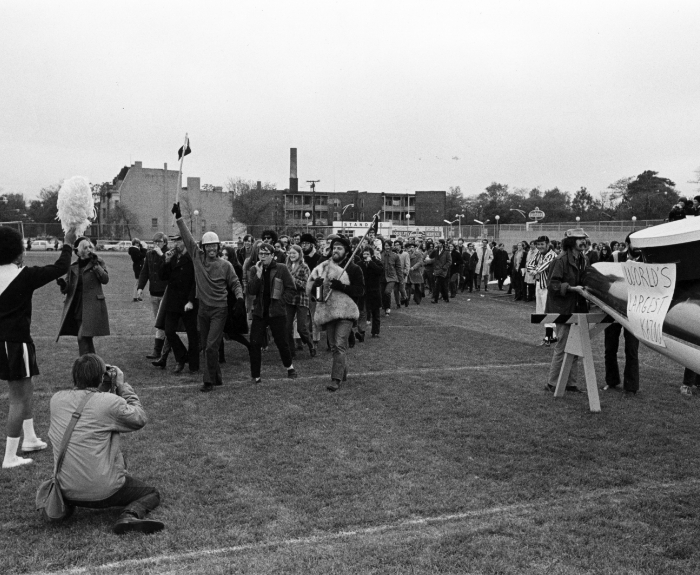
Donald Bingle: It was very free form. Where other marching bands would do formations of the initials of the university or complicated things, we would do things like Brownian motion.
Paula Szewczyk Ausick: Somebody would shout out a form, and they would wander around until the shape would come into being.
Barbra Goering, AB’74, JD’77: I was at football games where they brought out the big kazoo. You would do the famous amoeba formation, where you go out on the field and you just sort of mill around.
Paula Szewczyk Ausick: Of course, the opposing team just didn’t know what the hell was going on.
Hanna Holborn Gray, president of the University of Chicago, 1978–93: One of the first things that I did in my first couple of weeks was to take the mayor of Chicago [Michael Bilandic] to a football game at the University. We had a marching kazoo band. And he loved it. He said he always enjoyed high school athletics.
Donald Bingle: My sophomore year, I think the team scored 14 points at home games: seven in the first game and seven in the last game.
Bruce Gluckman: If Chicago ever decides to become a Division One team, that’s the moment I’ll probably die.
Donald Bingle: Ten to 15 years ago, I got contacted by the University. And they said, “Where is Big Ed?” and I said, “Well, 30 years ago it was under a light-green tarp in the maintenance building directly south of Stagg Field.” I found out later that there was now a children’s hospital there.
Paula Szewczyk Ausick: He was never found.
Donald Bingle: I put it on every resume I have ever used. The last entry is always “Former Keeper of the World’s Largest Kazoo.” Because you always need something to talk about in interviews.

The Lascivious Costume Ball
There’s no one answer as to what, exactly, the Lascivious Costume Ball was: a satyric satire of stuffy campus traditions; a product of the free-love, libertine ’60s; a distraction; a disaster; a good time. The LCB—with an entry fee inversely proportional to the amount of clothing you wore—made its debut in 1969 and met its demise in 1984.
—Shiloh Miller, Class of 2026
Dorthea Juul, AB’72, PhD’89: It was pretty lascivious.
Paula Szewczyk Ausick, AB’72: The first one took up all of Ida Noyes.
James Lawrence Fuchs, AB’76, AM’77, PhD’83: I actually did consider going my senior year, but I was too busy working on my BA paper.
Hanna Holborn Gray, president of the University of Chicago, 1978–93: The ball was invented by very imaginative students with a talent for comedy.
Dorthea Juul: One of the women in my class was involved in this Students for Violent Non-Action group. I think they were involved in organizing, SVNA. I think they were trying to make more fun on campus.
Dan B. “Skip” Landt, AM’62, assistant dean of students and student activities director, 1967–75: They made it sound very innocent.
Paula Szewczyk Ausick: It was a highly political event. It talks to the satirization of some of the old traditions at the U of C. There was this Miss University of Chicago. There was Washington Prom [a formal dance held in February, which included the Miss University of Chicago contest] that the student government spent money on. Someone said there were only 14 couples that went. What a waste of money. It didn’t fit in with what was happening in the culture at the time.
Pamm (Reichl) Collebrusco, AB’72, AM’74: I ran for Miss University of Chicago. I remember going to Saks Fifth Avenue and buying this macramé dress that was completely see-through. I wore regular stuff underneath it. It was kind of a fun thing to do. I don’t know if the other students thought it was that great.
Paula Szewczyk Ausick: I think I was nominated one year, by The Maroon, and I was really angry at The Maroon. How could you do this to me? We also had, on campus, a Victoriana festival. And I went to a lecture called “The Whip That Tickles,” about Victorian pornography. Here we are in the coffee shop in Mandel Hall. I was sitting there with some members of SVNA. “Oh, another Wash Prom.Can you believe they’re doing another Wash Prom?” And as we were kvetching about this, the idea came up of holding a counterculture prom.
Skip Landt: Students came into my office saying, “We’d like to hold something called the Lascivious Costume Ball.” “What would that be?” They said, “Well, we got some old Army films about VD.”
Roger Black, EX’70: There were small amounts of money in Student Activities that you could liberate with any kind of reasonable proposal.
Paula Szewczyk Ausick: The lasciviousness came into it because I had “The Whip that Tickles” embedded in the brain. What would be lascivious? Well, we would have people pay to attend.
Bill King, AB’69: It had a graduated admission price. It was $3 or something if you came as you were. It was a dollar if you were in a lascivious costume.
Paula Szewczyk Ausick: And if you came nude, you got in free.
Skip Landt: How dumb could I be? I’d like to think I understood what they were really doing. I don’t think I did.
Julian Brown, AB’77, AM’78: There was streaking through the Lascivious Costume Ball, which was kind of pointless, since people were naked anyway.
Paula Szewczyk Ausick: The fact that the administration allowed it to happen says something.
Skip Landt: There was certainly a feeling that if students can do something to keep their high spirits away from politics, that’s fine. That must be the reason why I didn’t push it very hard.
Paula Szewczyk Ausick: There were people there not only from the College, but graduate schools and the medical school. And medical interns, some low-level administrators, secretaries.
Donald Bingle, AB’76, JD’79: Because the University ID requirement was so strictly enforced, there was always a line. From inside Ida Noyes, you could see cars coming down Midway Plaisance. They would see this line, and the car would start to drift and hit the curb. Sometimes it would lose the hubcap, sometimes it wouldn’t, but no one stopped.
Hanna Holborn Gray: An assistant dean heard that she was to be a chaperone at a student ball, and so she dressed very well, in a ball gown. She was the chaperone at the Ida Noyes swimming pool. And she sat there in a chair and was stunned when all these nude figures appeared at the swimming pool. She never quite recovered, so her stay with us was rather short.
Bill King: They sent an administrator to the Lascivious Costume Ball to guard the door, because they were afraid that there was going to be a police raid of the event.
Jim Vice: There was a fellow running for state’s attorney in Chicago. And there was great concern that he would try to raid this party as a political gimmick.
Skip Landt: All the deans and assistant deans and associate deans were in formal wear and came dressed, early, and gathered someplace near the door. So people coming to the door couldn’t see anything, just very neatly dressed people. So when the police came the first time, they said, “We understand there’s something terrible going on here.” “No, we’re having a little dance. Just strictly students, our own students.” “Well, OK.”
James Lawrence Fuchs: They showed pornographic movies, I was told.
Skip Landt: So, an hour and a half later, the police came back. “We understand there really is something going on here and we have to get in.” “Look, we have identification cards, we’re deans of the College, we’re officials, we’re in charge.” “Well, OK.”
Leslie Strauss Travis, AB’73: They had a homecoming queen, and it was a Frigidaire refrigerator. It was not a live human being.
Skip Landt: There was a large quantity of grapes that people rolled in. I don’t understand how that happened.
Paula Szewczyk Ausick: You’re going back to Roman times. Huge mats and pillows on the floor and women going around and feeding you grapes.
Skip Landt: The third time the cops came back, fortunately it was late. And they said, “We have to get in. We were told there was awful stuff taking place here.” “Look, we’re closing in five minutes. Give us a break.” And they did.
Julian Brown: They quit having it for some reason. I forgot why they quit having it. Maybe it was because of the energy crisis?
Hanna Holborn Gray: I was the person who shut it down.
Dorthea Juul: One of the reunions I went to, I went to hear Hanna Gray talk. She said, yeah, I had to put a stop to that Lascivious Costume Ball because it got to be, you know, too much.
Paula Szewczyk Ausick: I think it lost its political origins, but still, it was a lot of fun.
Hanna Holborn Gray: Many traditions get started and are wonderful, and over the years they take on a different form and no longer have the kind of original inspiration, and people need to invent new things. I think that’s part of the joy of student life.
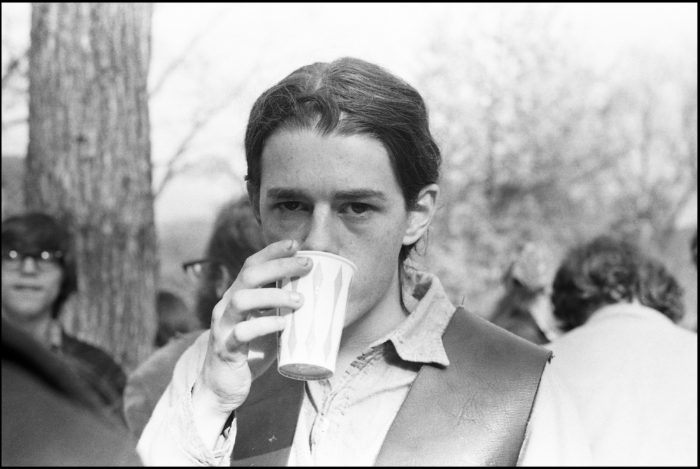
Students for Violent Non-Action
The satirical group Students for Violent Non-Action, or SVNA, which began in the 1960s, was responsible for many of the defining elements of student culture at the College in the 1970s.
—Rory McGann, Class of 2025
Bill King, AB’69: We had the Vietnam War going on, the civil rights movement was in full bloom, as well as the women’s movement. And so there were a lot of angry people on campus.
Leslie Strauss Travis, AB’73: I went to the U of C from ’68 until I graduated in ’73. There was not a single year that I was there when classes were not interrupted by some kind of major sit-in or protest that shut down the University or changed the grading curve very radically.
Bill King: There was a sit-in because the University was creating a separate class ranking for men and providing that information to the Selective Service. If you were not doing so well in college, you had a better chance of getting drafted.
Alice Leiner, AB’74: There was a pervasive atmosphere of unrest and violence—people being afraid of being shipped off to a senseless war and not coming back.
David Travis, AB’71: I had my physical on the day we invaded Cambodia. I called my draft board in Nebraska. I said, “I’m calling about the lottery. I have the number 211.” And a very polite person said, “Oh, you have nothing to worry about. Everybody will get to go.”
Bill King: There was a group of individuals who felt that their input wasn’t being solicited with regard to a particular professor who was up for tenure, Marlene Dixon.
Paula Szewczyk Ausick, AB’72: She was denied tenure. And embedded in that was the idea that women weren’t really getting equal due.
Bill King: There was another big sit-in in 1969. And this time, the administration appointed people to go in and take names of people who were in the sit-in and expelled a bunch of students. So our graduation ceremony was pretty tense.
Jim Vice, EX’55, AM’54, various administrative and teaching positions, 1953–75: It was dreadful, because I knew so many students. I ended up identifying something like two-thirds of the people who appeared before the disciplinary committee.
Seth Masia, AB’70: A lot of people reacted to their environment with intentional chaos, like the Students for Violent Non-Action.
Julian Brown, AB’77, AM’78: They were a pun on SNCC [Student Nonviolent Coordinating Committee].
Jim Vice: SVNA was a kind of parody of SDS [Students for a Democratic Society].
Paula Szewczyk Ausick: Frank Malbranche was their alter ego. They all named themselves that, whether they were male or female. I did know two of them: Steve Landsman [EX’69] and Bill King. They were head honchos.
Bill King: Steve Landsman was a very interesting guy. I remember sitting in a dorm room in Hitchcock one evening and him coming up with this idea to do some sort of absurdist alternative to all of the serious stuff that was going on.
Jim Vice: He was quite delightful and zany.
Roger Black, EX’70: Steve Landsman had a nom de plume, Frank Malbranche. He got a group of people together and they took over WHPK. Somebody from the Sun-Times asked why. He said, “Didn’t you ever read Trotsky? That’s the first thing you do in a revolution: Seize the radio station.”
Paula Szewczyk Ausick: Students for Violent Non-Action was a satirical political performance group. They were just absolutely brilliant, highly creative.
Bruce Gluckman, AB’75: They really weren’t hardcore revolutionaries. They were just merry pranksters.
Ron Gagnon, AB’79: They struck me as just a little silly. I got that they had a kazoo band.
Bruce Gluckman: They were renowned for taking vats, large plastic vats, filling them with grain alcohol and dry ice and Kool-Aid.
Paula Szewczyk Ausick: They had social events on the quads where they had their SVNA cocktail.
Dorthea Juul, AB’72, PhD’89: It would foam up.
Roger Black: SVNA punch is easy. Equal parts lab alcohol and Hawaiian Punch. Do not mix. Simply pour into a galvanized steel drum over dry ice.
Alice Leiner: I didn’t have a lot of it. I made it to class.
Paula Szewczyk Ausick: They’re the precursors of the type of comedy-plus-news that you see today. Colbert, The Daily Show. They sort of combined the spontaneity of Second City with this very satirical look at politics and culture.
Barbra Goering, AB’74, JD’77: We were told over and over again by Dean John Boyer [AM’69, PhD’75, author of The University of Chicago: A History] that our class, which was entering in 1970, was chosen to be a quiet class.
Hanna Holborn Gray: When I became president, we had a next generation of students who had not experienced the ’60s. That did not mean that they didn’t have serious matters on their minds, but they were not in the business of protest so much as students had been in the ’60s.
Julian Brown: It was pretty quiet when I was there. The war was more or less over. The draft was over. There wasn’t much going on. There was the Spartacist Youth League, the Socialists, Communists. They would sell their paper and talk about running dog lackeys and capitalist lackeys. But I didn’t have much sympathy for them. We read Marx in Self, Culture, and Society. I had to spend the summer working in a steel mill, and I thought he was, frankly, wrong. The guys in the steel mill—you can say a lot of things about them, but “alienated” was not one of them.
Alice Leiner: The country was in a lot of tension and upheaval, and it was reflected on campus. SVNA spoofed some of the seriousness with which we had to confront life. It was a welcome relief.
SVNA Punch
For quantity, use 10 pounds of sugar, twenty packages of cherry and grape cool-aid, one quart of Real Lemon, three to five cans of Hawaiian Punch, seven to nine gallons of water, and 3/4 to 1 1/2 gallons of Reagent-grade ethanol. Mix the things in a large (10 gallon) plastic waste basket. After it has been mixed, add several pounds of dry ice. Not only is the surreal bubbling of the sauce good theater, but the brew is also cooled and carbonated. The stuff is also quite powerfully activated.
Cost: You can afford this only if you can find friends in a chem. lab. If you can, about $6.50 for 10 gallons.
From the Hyde Park Cook Book by Leslie Strauss Travis, AB’73.

Pierce Tower: A Lawless Land
The corner of 55th and Woodlawn, home to Campus North Residential Commons, was once the site of an alternate universe, Pierce Tower. Built in 1960 as a dorm for men, it was a tempest of testosterone during the 1970s. Pierce became fully coed in 1981 and was demolished in 2013.
—Rory McGann, Class of 2025
Bruce Gluckman, AB’75: You know the movie Animal House?
Donald Bingle, AB’76, JD’79: The water fights were epic enough that we shrank the carpet in the hallway.
Bruce Gluckman: The resident master was a guy named Robert Stein [associate professor of English], and he handed out little popcorn buckets that ended up being the weapon of choice for water fights. We were very serious about our studies too, mind you, but there was bust-out time sometimes, usually on Fridays, and we committed. That’s to say there was a lot of water.
Alphine Jefferson, AB’73: I have no recollection of water fights. I spent a lot of time in the library.
Leslie Strauss Travis, AB’73: The boys’ dorms had housecleaning come in once a week to clean their dorm room. The girls’ dorms were not like that.
David Travis, AB’71: Oh, that was just for sanitary … Fungus could be growing.
James Lawrence Fuchs, AB’76, AM’77, PhD’83: Someone had figured out a way to be able to make long-distance calls by inserting a penny, so Thompson [one of the houses in Pierce] guys made numerous calls to Trunk Island [in Bermuda] and the like. No one knew anyone on Trunk Island, of course. I recall vaguely that the phone company was investigating, but I am not positive about that.
Donald Bingle: Rumor is that someone rappelled out of their window down to the roof of the cafeteria in Pierce Tower, greatly upsetting the women on the third floor as they went past.
Alphine Jefferson: Early on I became the switchboard operator at Pierce Tower. “Pierce Tower. Can I help you? No, Mrs. Abramovitz, no. Aaron is not here. He has gone out with his girlfriend. He will be back. Yes, I will tell Aaron to call you.” Everybody liked me because I knew their business.
James Lawrence Fuchs: I was actually elected chairman of my dormitory my third term, but I was viewed as the lesser of three evils. One of my competitors was so unhappy about the fact that I had defeated him, he was attempting to disrupt the one and only meeting I held and had threatened water balloons. So I wore a bathing suit under my clothes.
Donald Bingle: I still have a scar on the inside of my mouth where I collided with somebody, slipped on the carpet, ran into the wall, and managed to bite into my lip.
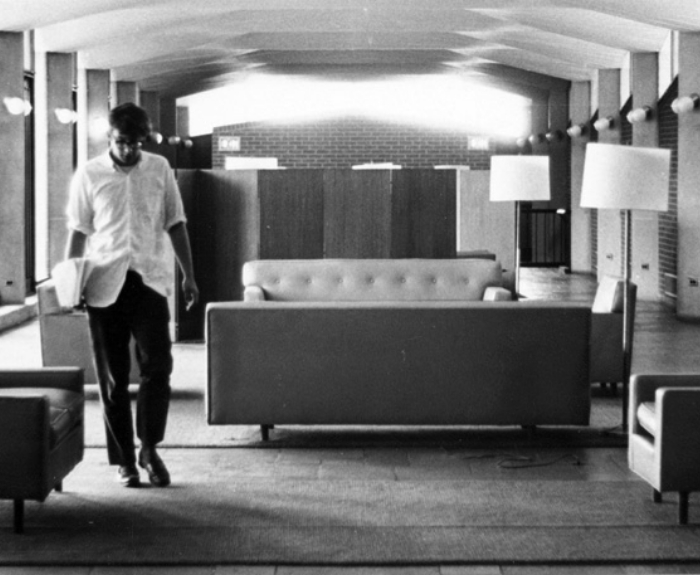
Alphine Jefferson: I didn’t participate in any of the silly activities. If someone had poured water on me, I would have done them harm.
Bruce Gluckman: We did crazy-stupid physics experiments. Fitting together Coke cans, putting in a little butane, throwing in a tennis ball, lighting it, and shooting it across the hallway. We were not very well-behaved sometimes.
Donald Bingle: We had tennis ball cannons. You would put together several pop cans so they made a cylinder, stuff a tennis ball down it, and then put lighter fluid in the bottom. Then you would point it out the dorm window on the 8th floor and light it, and a flaming tennis ball would shoot out the end.
James Lawrence Fuchs: One person set fire to my room.
Donald Bingle: We made an effort, for several evenings, to try and hit the Field House from Thompson. I don’t think we ever succeeded. We also tried to hit the Chicago Theological Seminary [then on the other side of 55th Street] with a paper airplane from the 8th floor. It took us something like 400 tries to get a paper airplane to actually hit the seminary. And of course that left paper airplanes all over Garfield [Boulevard].
Bruce Gluckman: We were doing, you know, projectile trajectories. We were all involved in the project together, so in some ways it was all an effort to bridge the gap between the sciences and the humanities. It was a reflection of the Common Core in a practical kind of way.
James Lawrence Fuchs: A lot of students in my dormitory were real loafers and goof-offs. I remember this guy had put a bed in an elevator, and there was a woman who was sitting in the bed with him. They were going up and down the elevator while he was typing his social science paper.
Donald Bingle: Sophomore Christmas, a group of people from Thompson House dressed up one of the gargoyles above Hull Gate as Santa Claus.
Bruce Gluckman: There’s a building on 57th that I ended up living in my last two years. It’s not owned by the University anymore. If you go past that one [the 57th Street Apartments at 1400 South Dorchester], that’s what the old Pierce Tower looked like.
Julian Brown, AB’77, AM’78: It was supposed to be called Pierce Towers, but they never built the second one.
Frank Gruber, AB’74: We had fun, but it was makeshift. The University didn’t do very much for the students, and that’s one of the reasons why so many kids dropped out.
Bruce Gluckman: We were all subject to the draft. That made the zeitgeist kind of frenetic sometimes, even though there was a lot of work. But in some respects, we were probably given a little more leeway.
Donald Bingle: My good friend and I put our heads together and we correctly figured out who was most likely to drop out of school during the summer. We put their rooms down as our first choices, and we both ended up with single rooms because we guessed who would drop out of school. I think I still have the key to my dorm room. But Pierce Tower isn’t there anymore.

Academics: Sleepout, sherry hours, a brand-new library
Like today, the students of the ’70s had their own set of academic rituals, larger-than-life professors, and career-altering courses. They were also the inaugural patrons of the Joseph Regenstein Library, the Brutalist edifice at the heart of campus that quickly became a fixture of academic and social life.
—Shiloh Miller, Class of 2026
Alphine Jefferson, AB’73: Had I known the University of Chicago was the University of Chicago, I would have been so intimidated that I would have failed out instantly.
Bill King, AB’69: This was right at the tail end of the old Hutchins Common Core–type thing. So your first two years were pretty much laid out for you.
Dorthea Juul, AB’72, PhD’89: The curriculum has gotten much more flexible nowadays.
Barbra Goering, AB’74, JD’77: You had to pass a swimming test or take physical education. I learned in Ida Noyes. It was Winter Quarter, and I had hair down my back. I remember walking to my class with my hair icing over.
James Lawrence Fuchs, AB’76, AM’77, PhD’83: Study abroad was not something that occurred. When I was an undergraduate, that was not allowed.
Alphine Jefferson: An apartment was built onto Pierce Tower for the chairman of the German department, Kenneth Northcott. I mentioned to him that I wanted a study abroad experience. He said, “Well, I know somebody at the University of Warwick. I can probably arrange for you to go there.” So I went to the University of Warwick in the fall of 1971.
Leslie Strauss Travis, AB’73: I took every class I could with Norman Maclean [PhD’40]. I took every class I could with John Cawelti. I took every class I could, which was only one, with Karl Weintraub [AB’49, AM’52, PhD’57].
Alice Leiner, AB’74: I lucked out and had Karl Weintraub for Western Civ.
Julian Brown, AB’77, AM’78: His Western Civilization class—people who wanted to get in would camp out to get dibs on registration.
Ron Gagnon, AB’79: Yes, that was done. Although people kind of thought it was silly. It was sort of like, “Really? You have a crush on a Western Civ professor.”
Julian Brown: I met Weintraub, but I’m not one for guru adorations.
Alphine Jefferson: I am very proud of the seven D’s I earned at the University of Chicago. I worked harder for my seven D’s than I did for my seven A’s.
Leslie Strauss Travis: Herman Sinaiko [AB’47, PhD’61] was willing to let students put together their own classes that he would then teach for free. He said he couldn’t give us credit for them, but he also wouldn’t charge tuition.
James Lawrence Fuchs: I took an intellectual history class with Leonard Krieger, which was basically the reason I ended up going to graduate school in European history.
Dorthea Juul: You’d be lined up to get into Regenstein at 10 in the morning or whenever it opened.
Julian Brown: Regenstein was like something out of Space Odyssey, this limestone plinth that just popped up out of the ground. It was just grass and pff ... Regenstein.
Dorthea Juul: The Regenstein was a big social scene.
Julian Brown: They began to have a café that kind of evolved from vending machines to a little coffee shop.
Dorthea Juul: I remember going down there and getting chocolate milk.
Ron Gagnon: I worked for the library. I had an office down in the basement—that’s where I wrote my bachelor’s thesis. It was absolutely quiet. So many books, insulated by so much paper. I could have survived a nuclear attack down there.
Alice Leiner: We had someone staying in our apartment in Hyde Park who broke into some kind of draft facility or burned draft cards—he committed some kind of federal crime. We didn’t know. We let him crash at our apartment, and he later was investigated by the FBI. And they came in [to the Regenstein] to interview me and flashed their badges, and the security guard wouldn’t let them in because they weren’t U of C IDs.
Julian Brown: A lot of the intellectual, cultural life was around sherry hours. Different departments and faculty members would host these sherry hours.
Leslie Strauss Travis: They didn’t at the girls’ dorms. The boys had sherry hours.
Jim Vice, EX’55, AM’54: No undergraduate would drink too much sherry, and it would loosen faculty members a little. So when I was asked to be the Director of Housing in ’61, I said, “I will take it, but only if I can introduce sherry hours.”
Alphine Jefferson: My second year, Fred [director of admissions] and Alice Brooks moved into Tufts House. And they asked me to chair sherry hour. I had no idea what it was, but I said, “OK, I’ll do it.” I hosted people like Milton Friedman [AM’33], Mortimer Adler, John Hope Franklin, George P. Shultz, George Stigler [PhD’38], and Ed Levi [LAB’28, PhB’32, JD’35, UChicago president, 1968–75]. Very, very famous people.
Ron Gagnon: Winter Quarter my freshman year, I was at a sherry hour in Hitchcock, and I wasn’t feeling entirely confident about staying at the University of Chicago. Almost everyone had had a better high school education than I did. There was an astrophysics professor who was standing there holding a glass of sherry. I began to share with him my reservations. He listened carefully, then he said, “Well, I can tell you, that if you’re asking those types of questions about yourself, you belong here. You are exactly the kind of person this school was designed for.”
Hanna Holborn Gray: When I became president, I gave a big party in Ida Noyes. We had a different band on each floor, there was dancing, there was food, and the whole building was sort of rocking. And at the end, a young woman approached me and she said, very politely, “Thank you very much, this was a nice party.” And then she fixed me with a terrible look, and she said, “I hope you’re not planning to make this a fun school.”
Julian Brown: I know that there are some people who had a miserable time. I had a great time.
Paula Szewczyk Ausick, AB’72: It was intense on all fronts. To this day, when some of my friends who are from U of C and I talk about it, we say it made such an impression on us. It wasn’t your sort of like, oh, these wonderful, great four years. It’s the rest of your life.
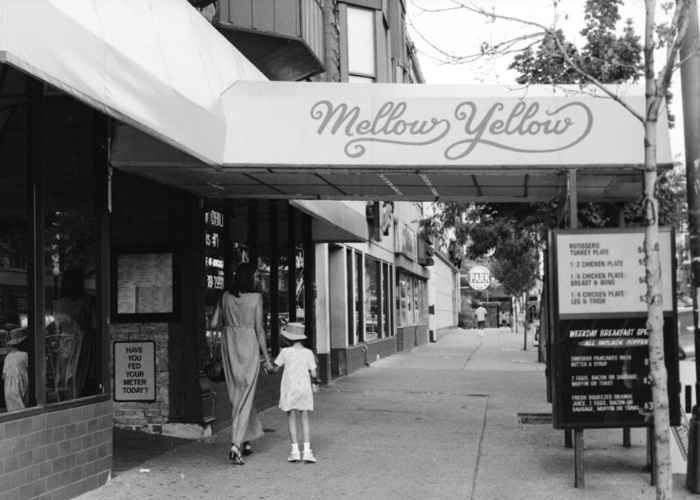
Food, drink, and entertainment
Alumni reflect on favorite spots in Hyde Park and Chicago 50 some years ago, from bygone bars to enduring student haunts.
—Shiloh Miller, Class of 2026
Alphine Jefferson, AB’73: The first message we got from the College was, do not leave the campus. Certainly do not go down to 63rd Street. Do not go downtown alone. As a Black person, I had traveled in Black communities all my life, so I was not intimidated. Every Sunday I walked to 64th and Kenwood, and I started attending a church.
Bill King, AB’69: There was an elevated line that ran down 63rd Street from Cottage Grove all the way to Stony Island. There were a bunch of businesses underneath the L tracks.
Julian Brown, AB’77, AM’78: There weren’t any restaurants in Hyde Park, hardly.
Ron Gagnon, AB’79: Just like today, there were many, many food joints all up and down 57th, 55th, 53rd.
James Lawrence Fuchs, AB’76, AM’77, PhD’83: People liked the restaurants in Hyde Park.
Roger Black, EX’70: The restaurants were horrible.
Julian Brown: There were restaurants in Harper Court. There was a restaurant called the Courthouse. Mellow Yellow came in in the mid-’70s.
Barbra Goering, AB’74, JD’77: On the corner of 57th Street there was something called the Dove, which was a diner owned by an elderly couple. That was quite the hangout for students and cops.
James Lawrence Fuchs: There was a very cheap Mexican restaurant called Luchito’s.
Dorthea Juul, AB’72, PhD’89: The Medici was one of the places you would eat at sometimes. It used to be in a different location. It was further east on 57th Street, over towards the IC [Illinois Central Railroad] tracks.
Julian Brown: There were no meals for Sunday dinner. So I would sometimes go to the Medici and have pizza.
Pamm (Reichl) Collebrusco, AB’72, AM’74: There was some bar that had peanuts. It was called Chances Are, maybe.
Roger Black: There were bars all over the neighborhood. Some of them were a little tricky for white kids to go into, but that’s where the music was. Real Chicago blues. And then there were some extraordinary, rich, gorgeous, nightclub bars that were beautifully decorated. Everyone was dressed up.
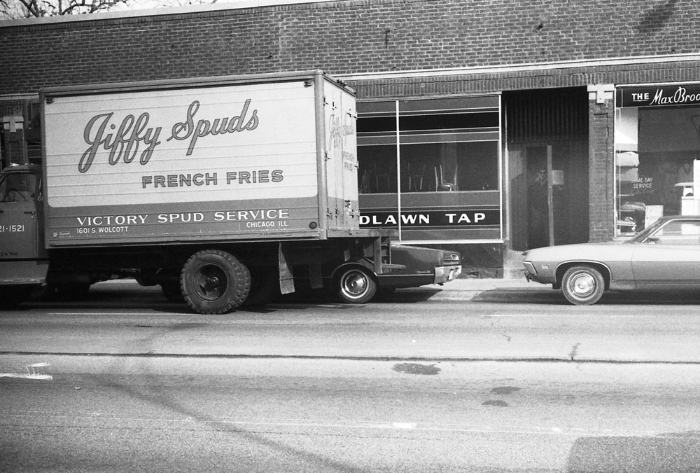
Alice Leiner, AB’74: We used to frequent the Eagle Pub, which billed itself as a quiet place to drink. And it was. But Jimmy’s—the Woodlawn Tap—that was, of course, a favorite haunt.
Pamm (Reichl) Collebrusco: Jimmy’s was a famous place to go. I had my 21st birthday there.
Ron Gagnon: You’d go there and get the Reuben or a hamburger. Those were sought after.
Alice Leiner: I think the drinking age was somewhat lower back then. Either that or we were very good at getting fake IDs.
Barbra Goering: I guess you could try sneaking in, but I didn’t have the personality for that.
Dorthea Juul: I used to borrow the ID of a friend a year ahead of me. But then she graduated.
Paula Szewczyk Ausick, AB’72: The legal drinking age was 21. I didn’t get to go into Jimmy’s unless I was with a graduate student.
Bruce Gluckman, AB’75: There was a 1950s-style open-air shopping mall, and the grocery store, the Hyde Park Co-op. I used to work in a men’s clothing store called Cohn & Stern, which is long gone. We worked in a polyglot atmosphere—University kids, folks from the South Side. It was run by two old Jewish guys. We were there to sell Levi’s and whatever was hip in those days.
Julian Brown: I think there’s a Trader Joe’s down there now.
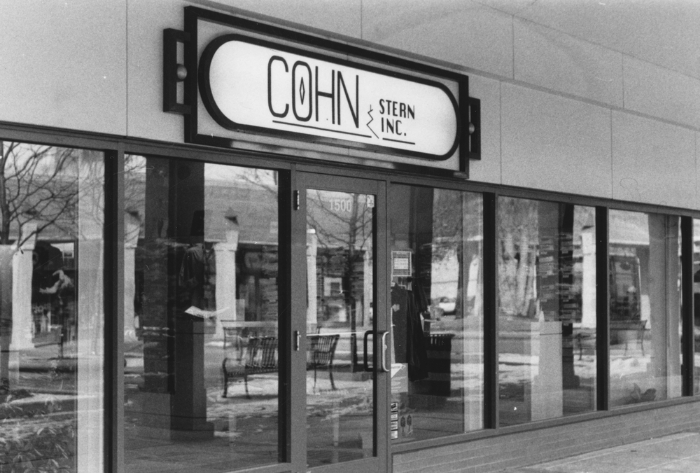
Barbra Goering: It felt like we always had too much studying to do to venture very far afield. We complained a lot about how it wasn’t much fun on campus, and there wasn’t anything to do, and all that.
Julian Brown: The University’s attitude was that, you know, you’re adults. You can find your own entertainment. And my view was that you had all of Chicago available to you.
Barbra Goering: The Loop was easy to get to because you had the bus and the IC.
Julian Brown: In Chicago in the ’60s, most of the trees were elms, and they died of Dutch elm disease. On the Midway you could stand on Ellis and look straight down and see—we call it the IC tracks, Illinois Central, you call it Metra Electric—and see the tracks.
James Lawrence Fuchs: Students would go downtown, to restaurants on Rush Street, to the different ethnic neighborhoods.
Pamm (Reichl) Collebrusco: We went to Greektown a lot.
Seth Masia: My good friend Craig Fujibayashi [EX’70] had the loan of an old Mercedes. Sometimes late at night we’d drive up to the North Side.
James Lawrence Fuchs: Along Rush Street, I ran into someone who was in one of my large lectures. He and I would never have spoken to each other on campus, but because we saw each other on the North Side, we instinctively said hello.
Pamm (Reichl) Collebrusco: I went to the North Side a lot. They had the Old Town School of Folk Music.
Alphine Jefferson: I would go downtown after the Water Tower Place had been built. And I ran into this old little gray man sitting there. And I said, “I know you. You are Mortimer Adler.” He had come out of a movie and I was going to a movie. I never made it because he and I went to have tea someplace and have a conversation.
Julian Brown: I would go down to the Jazz Showcase once a quarter, see Dizzy Gillespie.
Bruce Gluckman: I used to go down to the Jazz Showcase and listen to some of those guys, well-known people. McCoy Tyner, Sonny Rollins. People who knew Coltrane, played with Coltrane. It was on Rush Street. I could sit there in the audience, drink straight up whiskey, and smoke my Gauloises, because I was pretentious.
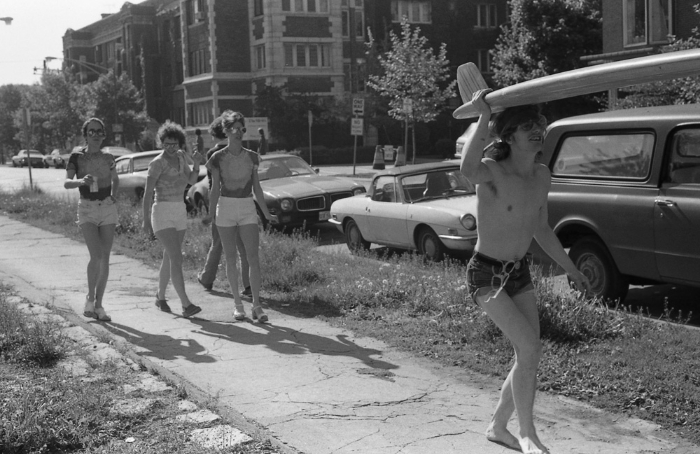
Dorthea Juul: A lot of people tried to get apartments in Hyde Park. That was the cool thing.
Frank Gruber, AB’74: It was much cheaper to live in an apartment than in the dorm.
Bruce Gluckman: We did a lot of our own cooking, especially third and fourth year when we had an apartment. We had a kitchen. We totally trashed that place. We were horrible, horrible people.
Barbra Goering: I loved Hyde Park in the summer. I would always stay, work, rent an apartment somewhere. I have very, very fond memories of sharing a sublet in the summer with various friends. I loved it after I graduated, too. It was a great place to raise a family.
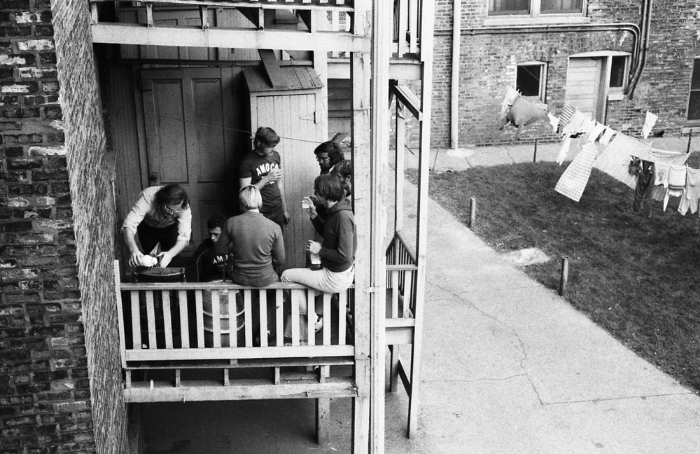
Read more about 1970s student life in “1970, Year of the yearBox.”
